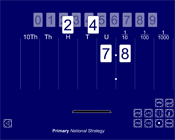Consolidation and practice
These resources are to support children in guided or independent work. Roll over the highlighted resource for a description.
Moving digits

This interactive teaching program (ITP) is an ICT-based tool to support the exploration of place value. Moving digits ITP allows the child or teacher to place and move digits on a place value board, investigating the effects of multiplying and dividing by 10 or 100.
Opportunities to use and apply
Possible contexts include:
- money, e.g. Converting pounds to pence: Gary collects 10p coins. Altogether he has £11. How many 10p coins is that?
- measures, e.g.
- Converting millilitres to litres. There are 1500 millilitres in this bottle. How many litres are there?
- I need 10 lengths of hardwood shelving, each 3.5 metres long. How much shelving is that altogether? At £20 a metre how much will it cost?
- scale, e.g. Increasing and decreasing quantities. There are 24 eggs in this tray. How many eggs would there be in 100 identical trays?
- applying to other calculations, e.g. those involving multiples of 10 or 100. For example:
- 71 × 20; 15 × 300; 30 × 40 × 10
- What is £3000 divided equally among 20 people?
Confirming learning
Ask probing questions such as:
- Why do 6 × 100 and 60 × 10 give the same answer?
- My calculator shows 37. What single multiplication should I key in to change it to 3700?
- After completing a division my calculator shows 7.95; what number did I divide by 1000?
- I divide a four-digit number by 100. The answer is between 70 and 75. What could the four-digit number be?
- How do I convert 4527p into pounds?
- Tom says: ‘If I divide a four-digit number by 1000 it always has a number after the decimal point.’ Is he right? Explain your answer.
 Calculating
Calculating
